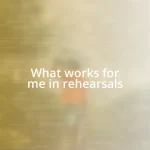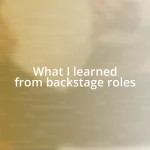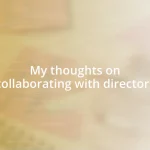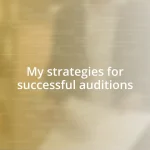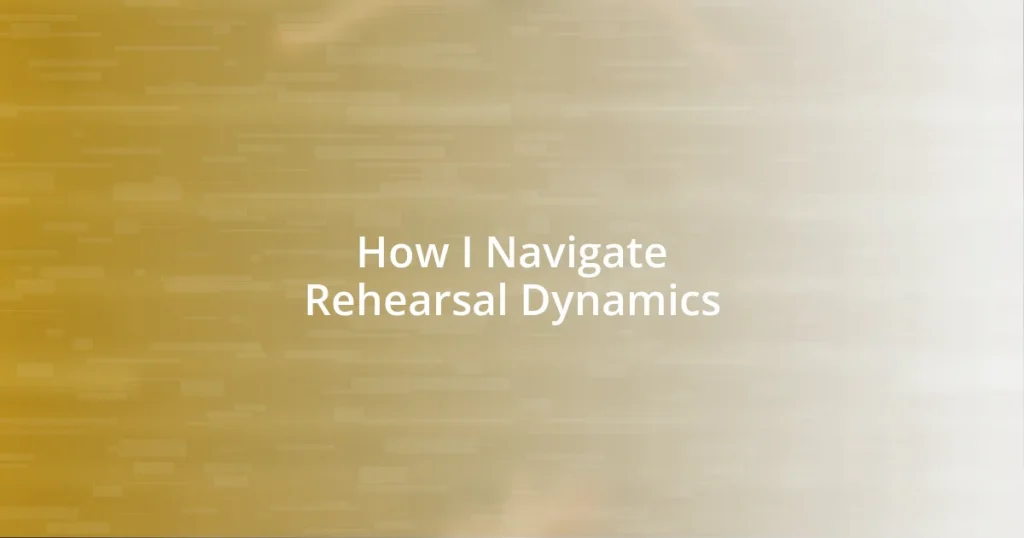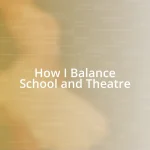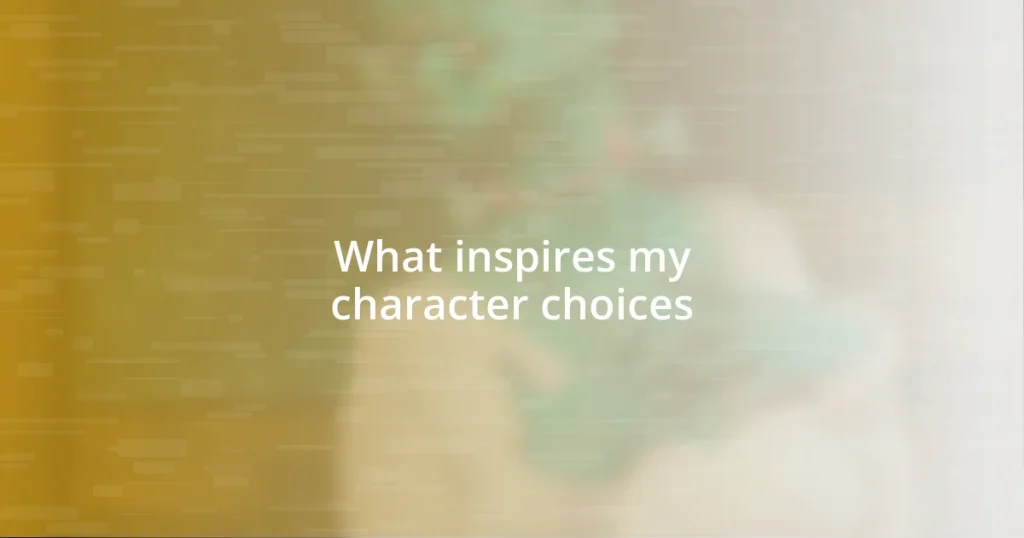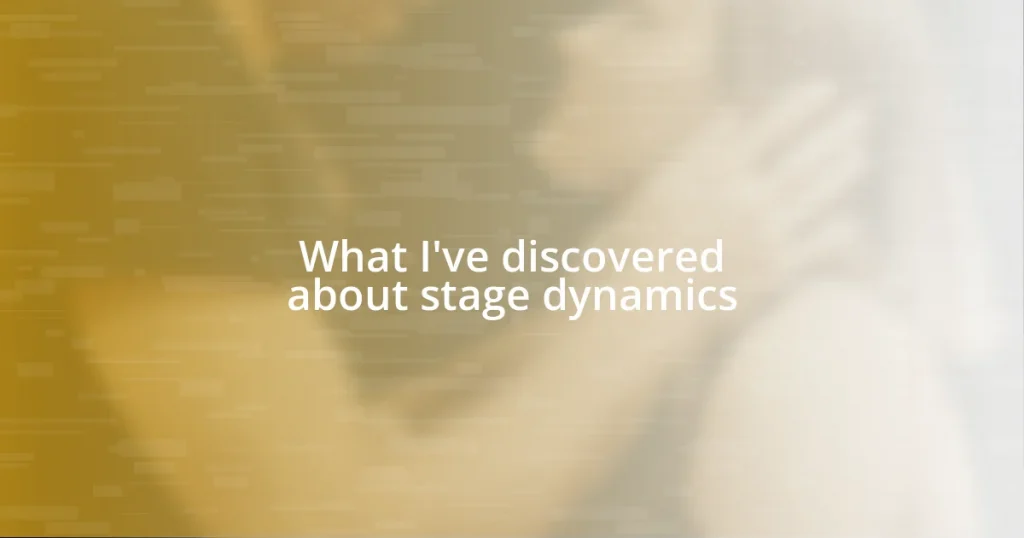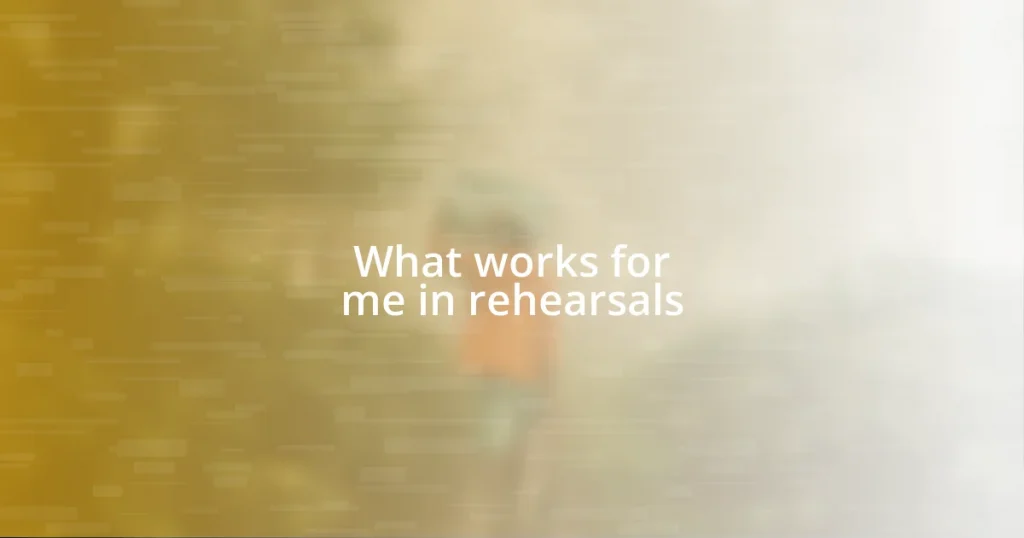Key takeaways:
- Understanding rehearsal dynamics involves fostering a safe environment for collaboration, where all participants feel valued and heard, leading to enhanced creativity.
- Effective communication techniques, such as active listening and open dialogue, are essential for unlocking the potential of each individual and strengthening team connections.
- Continuous improvement through feedback, reflection, and experimentation with rehearsal practices is vital for growth, allowing for deeper connections and richer performances.

Understanding Rehearsal Dynamics
Understanding rehearsal dynamics is an intricate dance between participants. When I first stepped into a rehearsal room, I was surprised by how the energy shifted depending on who spoke or how ideas were received. Have you ever noticed how certain voices can fill a space with enthusiasm while others might bring a reflective hush?
At times, I felt like a conductor, trying to gauge the mood and adjust accordingly. There were moments when a simple suggestion sparked a wave of creativity, igniting a passionate discussion that transformed our approach. It’s fascinating how the chemistry of a group can influence the outcome; have you ever experienced a breakthrough because someone shared a bold idea?
I’ve learned that understanding these dynamics isn’t just about managing personalities; it’s about fostering an environment where everyone feels safe to contribute. I still remember a particularly vulnerable moment when a fellow actor shared their struggles, and the room shifted from discomfort to solidarity. It’s in these moments of openness that true collaboration occurs, allowing us to explore the depths of our creativity together.
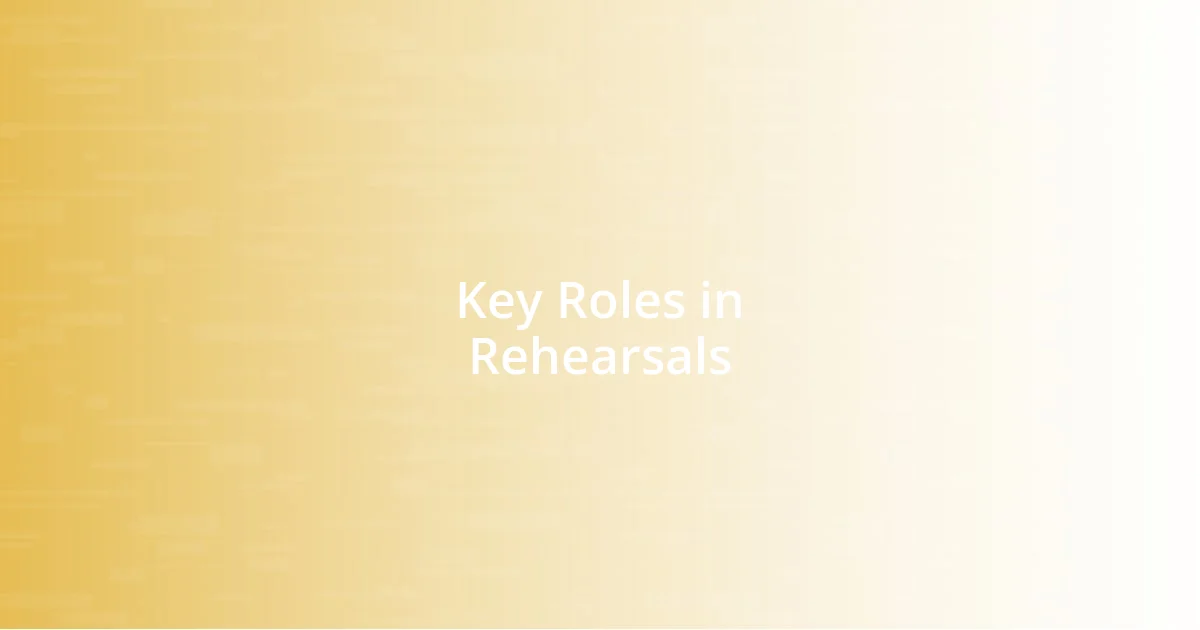
Key Roles in Rehearsals
The rehearsal process is not just a collection of individuals working on a performance; it’s a collaborative effort that relies on distinct roles to create an effective and harmonious environment. For instance, the director serves as the guiding force, shaping the vision and ensuring that every element aligns with the overall goal. From my experience, a great director knows when to step back and let the actors find their own way, trusting them to interpret the material while providing support when needed. Have you ever felt that shift in the room when a director was not just barking orders but listening? It truly makes a difference.
Equally important is the role of the stage manager, who acts as the backbone of the rehearsal process. In my early days, I underestimated just how crucial their presence was until I found myself lost in a chaotic rehearsal. The stage manager not only keeps track of cues and schedules but also ensures that communication flows smoothly. I remember a time when the stage manager gracefully coordinated last-minute changes, allowing us to adapt without losing momentum. Their calm and organized nature creates a safe space, instilling confidence in the entire team.
Actors, of course, are the heart of any rehearsal. Their ability to connect with the material and one another can transform a script into a living, breathing performance. I’ve experienced moments where an actor’s vulnerability on stage opened up a realm of emotional exploration, allowing others to respond in kind. It’s in that shared space of honesty and creativity that magic happens, leading to performances that resonate deeply with audiences.
| Role | Responsibilities |
|---|---|
| Director | Shapes the vision, interprets the material, offers guidance and support. |
| Stage Manager | Coordinates logistics, tracks cues and schedules, maintains communication among the team. |
| Actors | Bring the script to life through emotional connection and collaboration. |

Establishing Effective Communication
Establishing effective communication in a rehearsal setting is key to unlocking the full potential of each individual’s contribution. I’ve often found that creating a space where everyone feels heard is essential. There have been times when I realized that simply asking for feedback after a run-through made all the difference. Suddenly, hesitant voices started to surface, enriching our discussions and fostering deeper connections.
- Active Listening: I make it a point to listen intently when others share their thoughts. It shows respect and encourages more openness.
- Clear Expectations: Setting clear objectives at the beginning of each rehearsal helps prevent misunderstandings.
- Open Dialogue: I encourage a culture where questions are welcomed, fostering a collaborative environment.
- Body Language: I pay attention to non-verbal cues—sometimes a nod or a glance speaks volumes about someone’s engagement.
- Feedback Loops: I love implementing quick feedback sessions, allowing everyone to express their feelings about the process. It creates trust and can lead to breakthroughs.
Sometimes, it’s as simple as a coffee break where everyone shares lighthearted stories or insights about the performance. Such informal moments have often led to profound conversations that can shift our approach. It’s remarkable how laughter can lighten the atmosphere, making discussions flow more naturally. The energy after those chats always feels more connected and engaged, and I cherish those moments that foster genuine relationships—not just as colleagues, but as a creative family.
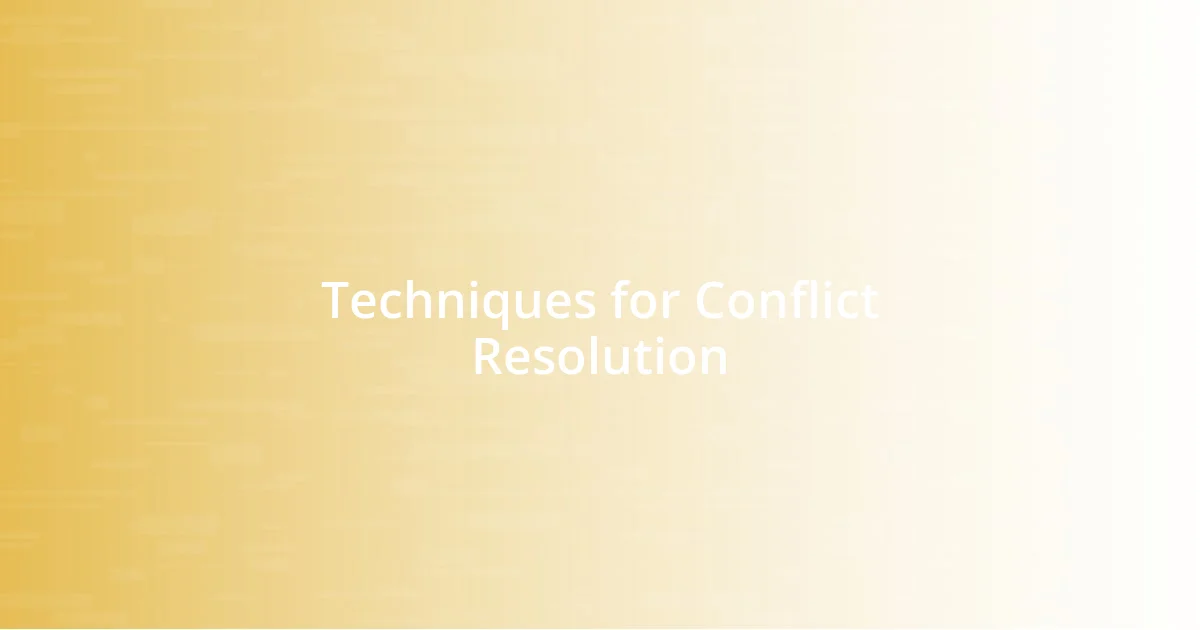
Techniques for Conflict Resolution
Navigating conflict in rehearsals can feel daunting, but I’ve discovered a few techniques that truly help ease tensions. One effective approach I often use is the “cool-off” period. When emotions run high, I simply suggest taking a brief break. I remember a rehearsal where frustrations erupted over creative differences. Just a few minutes apart allowed us to return with fresh perspectives and even some laughter to lighten the mood. Isn’t it fascinating how a little distance can recalibrate our thoughts?
Another handy technique I’ve found valuable is the use of “I” statements during discussions. Instead of saying, “You’re not listening,” I frame it as “I feel unheard.” This subtle shift changes the dynamic, often transforming a potentially combative situation into a constructive conversation. I recall a moment when a fellow actor seemed distant during a critical scene. Framing my concern in this way opened up a dialogue about what we were both experiencing, leading to a breakthrough in our performance. Have you tried this approach in your own collaborations?
Lastly, I believe in the power of brainstorming as a collective practice. When conflicts arise over creative choices or interpretations, I suggest we gather around and explore different solutions together. I vividly remember a time when our team hit a wall with the staging of a difficult scene. By bringing everyone into the conversation, we not only resolved the issue but also uncovered exciting ideas that we hadn’t considered before. Sometimes, conflict paves the way for unexpected creativity—don’t you find that such moments can spark the best revelations?

Balancing Leadership and Collaboration
Balancing leadership and collaboration in rehearsal is like walking a tightrope for me. At times, I’ve found that asserting my vision as a leader can push the creative boundaries, but it’s essential to remain open to contributions from the team. For instance, during a particularly ambitious production, I initially had a clear concept in mind. However, after encouraging team input, several cast members presented ideas that transformed it into something far more vibrant. It’s incredible how collaboration can breathe new life into an original vision, don’t you think?
Leadership also means knowing when to step back and empower others. On one occasion, I trusted a fellow actor to lead a portion of a rehearsal. I watched them own the room, and it made me realize the power of shared responsibility. Allowing others to lead not only fosters respect but also cultivates a sense of ownership among the team. These moments remind me of how valuable it is to create space for others’ strengths to shine.
Ultimately, it’s all about finding that sweet spot where everyone feels valued. I still remember the rehearsals where I openly acknowledged ideas, asking “What do you think?” as a habit. This simple phrase often sparked unexpected conversations, forging deeper connections within the rehearsal room. Isn’t it amazing how such a small gesture can set off a chain reaction of creativity? Balancing assertiveness and openness is key, and the results can be truly rewarding.

Evaluating Rehearsal Outcomes
Evaluating rehearsal outcomes is crucial for continuous growth and improvement. After each session, I often spend a few moments reflecting on what we achieved. I remember a time when we worked on a emotionally challenging scene; afterward, I asked my fellow cast members how they felt about our progress. Their responses opened my eyes to aspects I hadn’t noticed, reminding me how collective insights can deepen our understanding of the work we’re doing.
I find it valuable to revisit specific moments during rehearsal and assess them honestly. One particular rehearsal for a complex character dynamic left me feeling uneasy. I started asking targeted questions, like, “What did that moment feel like for you?” Surprisingly, this prompted a discussion that unveiled various interpretations of our characters, allowing us to align our intentions. Have you ever had that eye-opening moment where an evaluation leads to clarity?
Moreover, I always make sure to track progress over time. For instance, I’ve kept a rehearsal journal where I jot down key takeaways after each session. Looking back on them often reveals patterns in our dynamics that I hadn’t noticed in the moment. This regular assessment doesn’t just highlight where we excel; it also illuminates areas that need attention. Isn’t it inspiring how consistent reflection can steer us toward excellence in our craft?

Continuously Improving Rehearsal Practices
Continuously improving rehearsal practices is an ongoing journey for me, marked by curiosity and reflection. One approach that has truly helped is setting aside time for a “feedback round” at the end of each rehearsal. I remember one particularly intense session where emotions ran high, and I decided to ask everyone to share their feelings on the process. The variety of responses not only enhanced my understanding but also brought everyone closer, fostering a sense of trust that made future rehearsals even more productive. How often do we forget to create that space for open conversation?
I’ve also learned the value of experimenting with different rehearsal techniques. For instance, I once introduced a physical warm-up that involved improvisational games. To my surprise, this not only helped us bond as a team but also unlocked a wealth of unfiltered creativity. I couldn’t help but wonder: what potential breakthroughs lie in shaking up our routine? These shifts often lead to deeper connections among cast members, which ultimately enriches our performances.
Moreover, I actively seek inspiration beyond traditional methods. I recall a workshop I attended that focused on emotional connectivity through movement. Incorporating those lessons into our rehearsal added a fresh dynamic that I hadn’t anticipated. Remembering the excitement of that experiment drives me to keep exploring new ideas. Could it be that embracing innovation is the secret to mastering rehearsal dynamics? Each new practice I adopt feels like a piece of a larger puzzle, gradually revealing a clearer picture of what we can achieve together.


